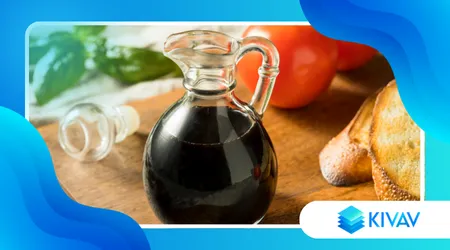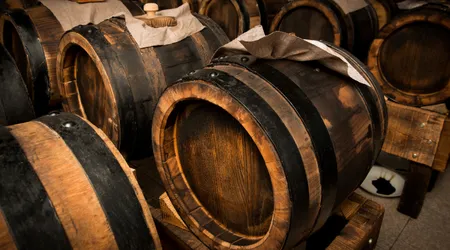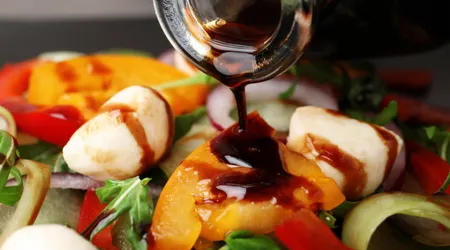Traditional Modena balsamic vinegar: a precious condiment worth knowing about.

Traditional balsamic vinegar of Modena It is much more than a simple condiment: it is a symbol of culture, patience and craftsmanship.
Announcements
Produced exclusively in the province of Modena, this dark, velvety elixir represents Italian gastronomic excellence, a heritage protected by the DOP label.
Its history, rooted in centuries of tradition, is intertwined with a love for the land and the dedication of families who transform grapes into a liquid masterpiece.
But what makes this condiment so special? How can such a simple ingredient elevate a dish to an unforgettable experience?
In this article, we'll explore the magic of this Emilian treasure, from its production process to its culinary versatility, with a special focus on how to celebrate it in 2025, a year celebrating sustainability and authenticity.
Announcements
Get ready for a sensory journey that will help you rediscover a unique product.
THE'traditional balsamic vinegar of Modena It's not just a condiment, but a tale of time and care. Its strictly regulated production uses only cooked must from local grapes like Trebbiano and Lambrusco.
This elixir matures in fine wood barrels for at least 12 years, acquiring complexity and harmony. In 2025, the growing focus on food traceability makes its value even more evident.
Each bottle, sealed by the Protection Consortium, is a guarantee of authenticity. Let's discover together how it's made, how to use it, and why it deserves a place of honor in your kitchen.
History: A Centuries-Old Heritage
The origins of thetraditional balsamic vinegar of Modena They date back to the Middle Ages, when Modena families jealously guarded their barrel collections.
Each vinegar factory was a microcosm of tradition, passed down from generation to generation. Twelfth-century documents mention a "special vinegar" offered as a gift to nobles and emperors.
This condiment, born as a symbol of prestige, has evolved into a gastronomic icon.
Today, in 2025, the Protection Consortium rigorously protects this heritage. The DOP designation, obtained in 2000, guarantees that every stage of production takes place in Modena.
The vinegar factories, often hidden in attics, are treasure troves of history and passion. Despite technological innovations, production remains faithful to ancient methods.
++San Marzano Tomatoes: Why They're So Popular in Italian Cuisine
Imagine a wine that ages for decades: thetraditional balsamic vinegar of Modena It's similar, but requires even more patience.
Modena families, like the Paltrinieri family, who have been in business since 1845, perpetuate this art. Each bottle is a piece of history, a link to the past.
Modernity hasn't diminished the authenticity of this process. Even in 2025, vinegar producers reject industrial shortcuts. Artisanal care makes every drop a unique experience.
Visiting a vinegar factory is like entering a temple of taste, where time is the true ingredient.

The Production Process: Art and Patience
Create thetraditional balsamic vinegar of Modena It's an art that requires time and precision. It all begins with the harvest of local grapes, such as Trebbiano and Lambrusco, between September and October.
The must is cooked over a low heat, concentrating the natural sugars. This thick liquid then ferments in barrels made of various woods, such as oak and cherry.
The racking process, which moves the liquid between barrels of decreasing size, lasts at least 12 years. Each wood adds unique notes: chestnut adds intensity, juniper adds an aromatic touch.
In 2023, the Palio di San Giovanni awarded the best producers among 1600 samples.
Patience is the heart of the process. There are no additives: just cooked must and time. The result is a sirupy condiment with a perfect sweet and sour flavor. The barrels, often centuries old, are the secret to this inimitable taste.
See also: Mixed Italian Antipasto: A Journey of Flavors and Traditions
In 2025, technology hasn't replaced tradition. Modern vinegar producers maintain manual methods, guaranteeing quality. Each bottle is tested by expert tasters. This rigorous approach ensures a product unmatched in the world.
The Unique Characteristics: Taste and Quality
THE'traditional balsamic vinegar of Modena It stands out for its dark color and velvety texture. Its intense aroma combines sweetness and acidity in perfect balance.
It is not a simple vinegar, but a versatile condiment that enhances every dish.
Quality is guaranteed by the Consortium, which only approves products that pass organoleptic tests.
The 100 ml bottles, designed by Giugiaro, are sealed with a serial number. There are two categories: Affinato (12 years) and Extravecchio (25 years).
The following table illustrates the main differences:
| Category | Minimum Aging | Label Color | Characteristics |
|---|---|---|---|
| Refined | 12 years old | White | Balanced, versatile flavour |
| Extra old | 25 years old | Gold | Intense, complex, precious |
This dressing is naturally gluten-free and vegan. Its consistency makes it ideal for refined dishes. A single teaspoon transforms a salad into a work of art.
In 2025, the trend toward sustainability is highlighting its artisanal production. Compared to industrial products, it offers an authentic experience. Its rarity justifies the high price.
Uses in the Kitchen: Versatility and Creativity
A thread of traditional balsamic vinegar of Modena It can revolutionize a dish. Traditionally used on boiled vegetables or meats, today it inspires creative chefs. Try a few drops on fresh strawberries for a surprising dessert.
Example: an arugula, pear, and Parmigiano Reggiano salad, dressed with a teaspoon of Affinato. The sweet and sour flavor enhances each ingredient. Or, a beef fillet with Extravecchio for an elegant touch.
Its versatility extends to desserts. A vanilla ice cream with a few drops of traditional balsamic vinegar of Modena It becomes a gourmet experience. By 2025, Michelin-starred chefs are using it in molecular dishes.
Don't cook it: heat alters its flavor. Use it raw to preserve its complexity. It's a condiment that demands respect.
Creativity in the kitchen knows no bounds. Try seasoning a fish carpaccio with Extravecchio: the result is unforgettable. Its intensity elevates every dish.
Why it is a Valuable Investment
The cost of thetraditional balsamic vinegar of Modena It may seem expensive, but it's an investment. A 100 ml bottle will last for months, thanks to moderate use.
In 2025, 70% of Italian consumers prefer PDO products for guaranteed quality.
Think of a diamond: small, rare, eternal. This condiment is similar, an accessible luxury that enriches everyday life. A single drop transforms a dish.
The price reflects the craftsmanship and time. Extravecchio bottles, aged 25 years, are perfect gifts for connoisseurs. Their rarity makes them unique.
In the global market, demand is growing. In 2025, exports to Asia and the US will increase, thanks to the product's fame. It is a symbol of Italian excellence.

The Future: Sustainability and Innovation
In 2025, thetraditional balsamic vinegar of Modena It aligns with the sustainability trend. The vinegar producers adopt environmentally friendly practices, such as the use of renewable energy. Tradition remains intact, but it evolves.
New generations of producers are experimenting with modern pairings. An example? A cocktail with Affinato and Prosecco, for a unique aperitif. Creativity keeps tradition alive.
Events like Acetaie Aperte (Open Acetaias) on September 24, 2025, allow visitors to tour the vinegar factories. These events educate consumers about the art of balsamic vinegar. The producers' passion is contagious.
The future is bright. Demand for authentic products is growing, and PDO is at the forefront. Its history continues to inspire chefs and gourmets.
Frequently Asked Questions
What is Traditional Balsamic Vinegar of Modena DOP?
It is a condiment produced in Modena with cooked must of local grapes, aged for at least 12 years, protected by the DOP trademark.
What is the difference between DOP and IGP?
The DOP (Protected Designation of Origin) requires local production and raw materials; the IGP (Protected Geographical Indication) permits external ingredients. The DOP (Protected Designation of Origin) is more exclusive.
How is it preserved?
Store in a cool, dark place, away from heat sources. An opened bottle will last for years.
Can I use it in my kitchen on a daily basis?
Yes, but in moderation. A few drops are enough to enhance salads, meats, or desserts.
Where to buy it?
Specialty shops, online vinegar shops, or events like TUTTOFOOD 2025 in Milan.
This journey into the universe oftraditional balsamic vinegar of Modena reveals a product that is art, history and taste.
In 2025, its authenticity and versatility make it a must-have for every kitchen. Whether you're a fan or a novice, a drop of this elixir will win you over.
Which dish will you transform first with this Modena treasure?
